and historical purposes, all rights reserved.
This page is copyright© by
This page may not be sold or distributed without
the expressed permission of the producer
I have no connection with any camera company.
For reference use on many Chinon
manual focus and metering cameras
This camera manual library is for reference
and historical purposes, all rights reserved.
This page is copyright© by ![]() ,
M. Butkus, N.J.
,
M. Butkus, N.J.
This page may not be sold or distributed without
the expressed permission of the producer
I have no connection with any camera company.
If you find this manual useful,
how about a donation of
$3 to:
M. Butkus, 29 Lake Ave.,
High Bridge, NJ 08829-1701
and send your e-mail
address
so I can thank you.
Most other places would charge
you $7.50 for
a electronic copy
or $18.00 for a hard to read Xerox copy.
If you use Pay Pal, use the link below.
Use the above address for a check, M.O. or cash.
Chinon CS PDF
manual
- direct from manual -
CLICK HERE TO CONTINUE TO
Chinon CS PDF VERSION OF THIS MANUAL

Chinon CS - meaning Chinon S cr ew thread
FEATURE IDENTIFICATION CHART
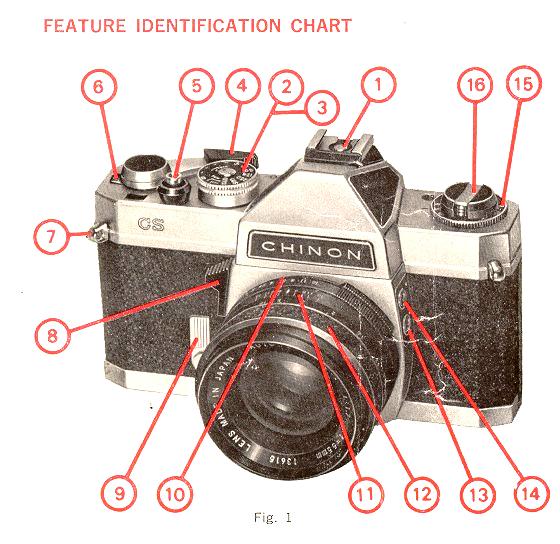 |
| 1. Accessory shoe (with direct flash contact) 2. Shutter speed dial 3. Film speed dial (ASA/DIN) 4. Film advance lever 5. Shutter release 6. Exposure counter window 7. Shoulder strap eyelet 8. Exposure-meter switch |
9. Self-timer 10. F stop ring 11. Depth of field scale 12. Distance ring 13. M synchro-flash socket 14. X synchro-flash socket 15. Film type indicator 16. Film rewind knob/Film chamber cover opening |
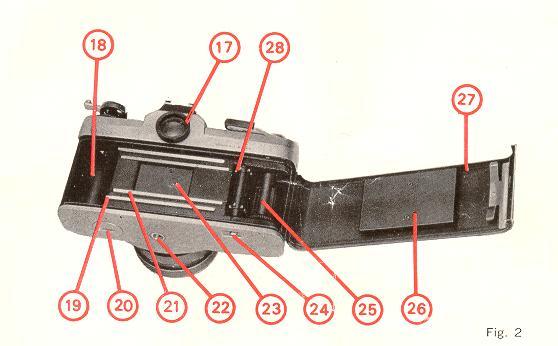 |
| 17. Viewfinder eyepiece 18. Film chamber 19. Film guide rails 20. CdS battery compartment cover 21. Film rail 22. Tripod socket |
23. Shutter Rewind button 24. Take-up spool 25. Film pressure plate 26. Film chamber cover 27. Sprocket teeth |
IMPORTANT!
BASIC STEPS IN PHOTOGRAPHING
(1) Insert CdS battery with plus (+) side up (Fig. 3). (see my page on mercury battery replacements at www.butkus.org/chinon)
(2) Load 35 mm film in
20 or 36 exposure cassette (Fig. 4).
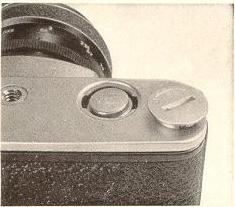 |
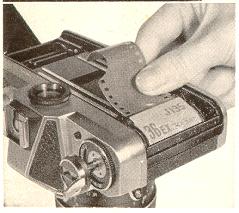 |
(3) Set ASA (or DIN) speed dial in accordance with the film speed specified on the film box (Fig. 5)
(4) Set either the
shutter speed or lens opening according to your photographic need (Fig. 6).
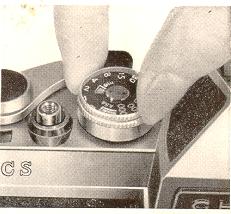 |
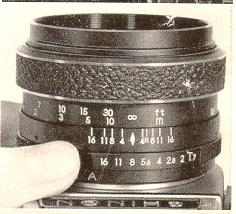 |
(5) Focus the lens (Fig. 7).
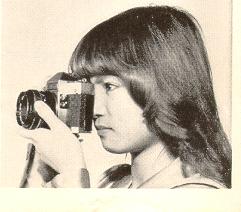
(6) Release the shutter (Fig. 7).
LOADING THE CAMERA
Use 35 mm film in 20 or 36 exposure cassette. It is recommended to load and unload camera in subdued light, e.g. shadow of your own body and not in direct sunlight.
(2) While rewind knob is still fully pulled up
insert film cassette into chamber with protruding end toward bottom of
camera. Press in film rewind knob. If it does not go in all the way, turn it
until it does.
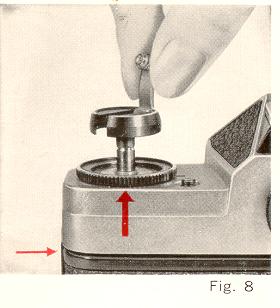 |
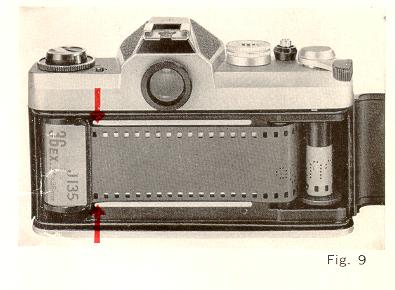 |
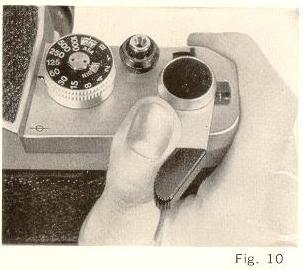
SETTING FILM SPEED (ASA/DIN)
The ASA (or DIN) speed of the film is specified on the film box or in the instruction sheet packed with the film.
Pull up and rotate the outer rim of the shutter
dial until desired ASA (DIN) number of the film shutter speed dial
(Fig. 11).
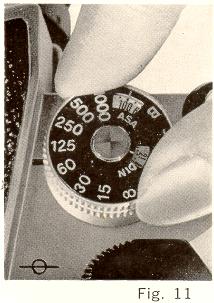
Also rotate film type indicator dial so that the
film type inserted shows to its pointer (Fig. 12).
This will remind you of the
type of film you are using.
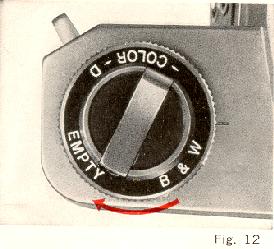
Some ASA (DIN) numbers are represented by a dot only. The chart below specifies the ASA (DIN) numbers.

CORRECT EXPOSURES
Correct exposure can be made by setting F stops on the lens and correct combination of shutter speed. As the CHINON CS camera has a built-in through-the-lens CdS exposure meter, you can take correctly exposed photographs.
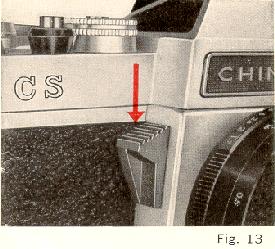
Depending upon the subject, rotate either shutter speed dial or F stop ring until the exposure indicator needle in the viewfinder comes to the complete horizontal position (Fig. 14).
If the needle is above the
horizontal position, it is overexposed (Fig. 15). Change the shutter speed
to a faster speed or use a smaller lens opening so that the correct exposure
combination can be obtained. If the, needle is below the
horizontal, it is under exposed so that a slower shutter speed or bigger
lens opening must be set.
Fig. 16
 |
 |
Release the exposure meter switch and slide AUTO/MANUAL control on the lens to Auto position (Fig. 18).
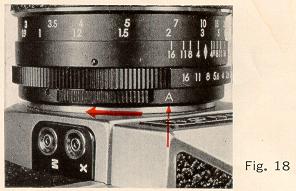
Turn the distance
ring first in one direction, then in the opposite direction until microprism
disc in the center of the image in the viewfinder is sharp (Fig. 19). Picture
is now focused. The distance scale may also be used for focusing. Estimate or
measure the camera to-subject distance in feet or in meters, then turn the
focusing ring. So the figure representing that distance is opposite the index
line.
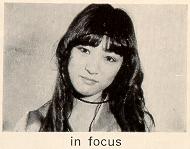 |
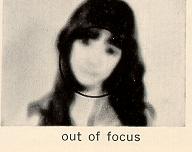 |
RELEASING THE SHUTTER
Hold the camera as steady as possible and press the shutter release slowly and
smoothly. When using slower speeds ranging from 1/30 to 1 second and "B"
(bulb) in poorly lit areas., use a tripod or other firm support to prevent
blurring the picture.
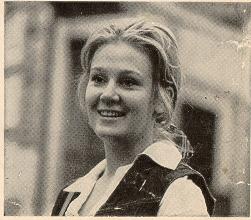
.
SETTING THE SHUTTER
The length of time for the film to be exposed, to light can be adjusted by
shutter speed setting. "60" (1/60-second) is recommended for subjects not in
motion.
It is recommended to use shutter speeds ranging from 1/125 to 1/1000 for subjects in motion. 1/1000 second speed will best "freeze" fast action.
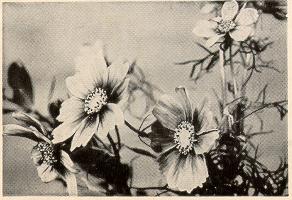
The " B" setting can be used for long exposures at night, using street lights or electric signs, or under poor light conditions when flash unit is not used.
UNLOADING THE CAMERA
When the red figure "20" or "36" (corresponding to 20- and 36-exposure film) appears in the exposure counter window lined up to the index mark, the end of the film has been reached.
Take the following steps for rewinding film into
cassette:
(1) Unfold crank on rewind knob (Fig. 20).
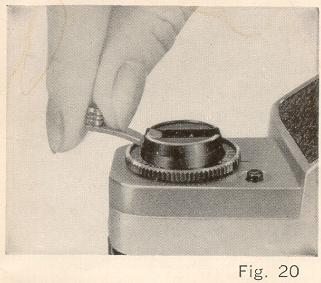
(2) Press in all the way rewind release button.
(3 Turn rewind crank lever clockwise. Tension is felt as the film is rewound from the take-up spool into the cassette. Stop rewinding when tension is released. Open camera back (by pulling out rewind knob all the ways and remove the film.
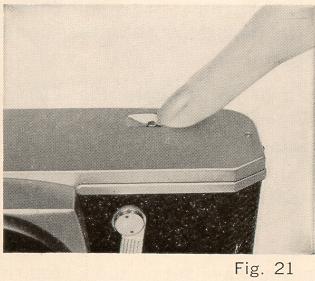
Have film processed without delay.
DEPTH OF FIELD
A zone of the picture in front of and behind your subject will also be sharp. The depth of this zone depends on the aperture selected. If you wish to know how much of an area will be sharp in the final picture, it can be predetermined in two ways:
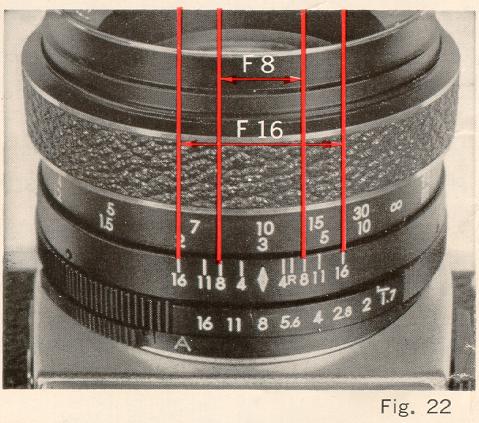
(A) Depth of Field Previewer
Slide the AUTO/MANUAL aperture opening switch to "M" (Manual) position. Set the lens to the selected aperture opening of the F stop ring. This will enable you to preview the area of sharpness in the picture before taking.
(B) Depth of Field Scale (Fig. 22)
After setting the lens opening and having focused on your subject, the area of sharpness in front of and behind your subject can be determined on the Depth of Field Scale. Locate on the Depth of Field Scale the same two F numbers corresponding to stop you have set on the F stop ring. The distance between these two F numbers on the focusing scale will be the area of sharpness in your picture.
SELF TIMER
The self timer permits the photographer to get into the picture. Place camera on tripod or other firm support (tripod socket is on bottom of camera). Get camera ready for exposure as usual. Push down self-timer lever (Fig. 23).
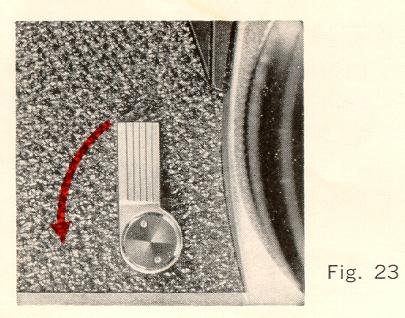
Depress shutter release to start self-timer. Exposure will be made approximately 8 seconds after the release has been pressed.
FLASH PICTURES
Most types of flash bulbs and also electronic flash can be used for flash pictures.
When using flash bulb No. 5, 5B, 25, 25B, M5, M5B, M2, M2B, AG1, 6, 6B, 8, connect flash cord to flash socket "M". When using . electronic flash or SM flash bulb, connect the flash cord to flash socket "X" (Fig. 24).
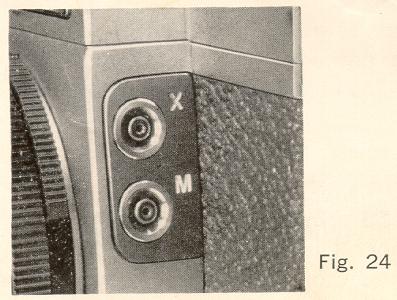
The use of Nos. 5, 5B, M5 and M5B flash bulbs as well as electronic flash. Nos. 6, 6B, 8 flash bulb is recommended for shutter speeds from 1/30 to 1/125 sec.
The use of Nos. M2, M2B, AG1, AG1B, SM flash bulbs is recommended for shutter speeds from 1/30 to 1/60 sec. Cordless flash units are slipped into the accessory shoe on the top of the camera. The accessory shoe may also be utilized for a flash unit having a synchro cord.
CHANGING THE LENS
A 55 mm lens is the proper focal length for general purpose picture taking. Any Chinon telephoto and wide angle lens or Pentax, Prinz flex or Sigma lens mount can be used. To remove the lens, push up the exposure switch on the camera body, holding it in one hand and grip the lens with the other, turning counter clockwise until it is removed.
To replace the lens, turn clockwise until secured in position finger tight.
IMPORTANT NOTE
When installing or removing the 55 mm F/1.2 Chinon lens, the exposure switch must be in " OFF " position (Fully up) or the focus ring must be turned to a distance setting of less than 0.9 M (3 feet) to avoid damage to the rear lens element.
CAMERA CARE
The CHINON Single Lens Reflex Camera is a precision instrument. Used with care, it will provide years of service.
Protect the camera from dirt, rain, dampness, and excessive heat. Avoid touching the lens. To clean lens, breathe on it, then wipe it gently with a soft, lintless cloth or tissue. Do not use eyeglass tissues as they might damage the lens coating.
It anything goes wrong, do not try to repair it. Take it to a dealer or send it to the nearest CHINON distributor.
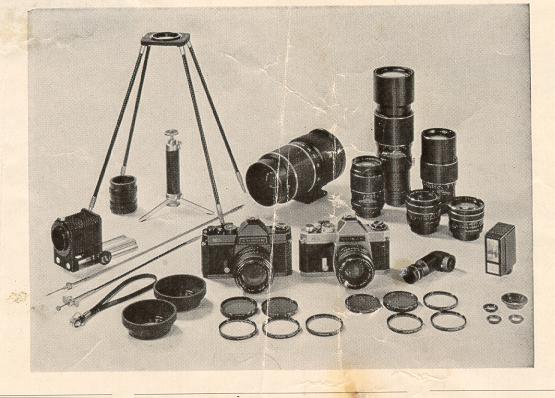
Interchangeable Lenses
28mm F 2.8 AUTO
100mm F 2.8 AUTO
135mm F 2.8 AUTO
200mm F 3.5 AUTO
300mm F 4.5 AUTO
500mm F 8 (Mirror)
Accessories stories
Auto Extension rings
Mini Copy stand
Table tripod
Angle finder
Bellows
outer eyepiece
Rubber lens hood (52mm)
Rubber lens hood (55mm)
Wrist strap
Filter (52mm) IA, UV Y2 ND4,PL
Filter (55mm) IA, UV Y2 ND4,PL
Cable release (20 inch)
Cable release (13 inch)
Eyepiece adapter - 2.5 Dioptor
Eyepiece adapter +.-1.0 Dioptor
Eyepiece adapter +3.0 Dioptor
Body cap
Lens mount cap